Gabriel von Seidl
| Gabriel von Seidl | |
|---|---|
 | |
| Born |
9 December 1848 Munich, Bavaria, German Confederation |
| Died |
27 April 1913 (aged 64) Munich, Bavaria, German Empire |
| Residence | Munich, Bavaria, Germany |
| Nationality | German |
| Alma mater |
Technical University of Munich Academy of Fine Arts, Munich |
| Occupation | Mechanical engineer, architect, interior designer, conservationist |
| Style | Historicist |
| Home town | Munich, Bavaria, Germany |
| Spouse(s) | Franziska Neunzert (m. 1890) |
| Children | 5 |
| Relatives |
Emanuel von Seidl (1856–1919, brother; architect, interior designer, engineer) Gabriel von Sedlmayr (1850–1931, cousin; entrepreneur) |
| Awards |
Verdienstorden der Bayerischen Krone ("Order of Merit of the Bavarian Crown") Pour le mérite für Wissenschaften und Künste ("Knight of the Order Pour le Mérite for Sciences and Arts") |
Gabriel von Seidl (9 December 1848 – 27 April 1913) was a German architect and a representative of the historicist style of architecture.
Life and work
Gabriel Seidl was born in Munich, Bavaria in 1848. He was the first son of the wealthy baker Anton Seidl and his wife Therese, daughter of the well-known brewer Gabriel Sedlmayr. Seidl initially studied mechanical engineering at the Polytechnic School in Munich. He worked as a mechanical engineer in England, where he found that his real talent lay in the field of architecture. Consequently, he began studying at the Academy of Fine Arts in Munich. His studies were interrupted during 1870–1871 due to his volunteer participation in the Franco-Prussian War. After an extended period of study in Rome, he opened an interior decoration studio in 1878.
Seidl was a member of the Bavarian Arts and Crafts Association founded in 1851 and quickly won the admiration of its members, including Lorenz Gedon, Rudolf von Seitz, and Fritz von Miller. In 1900 Gabriel Seidl was awarded the Verdienstorden der Bayerischen Krone ("Order of Merit of the Bavarian Crown"). Thereby he was raised to the peerage and became Ritter von Seidl. In 1908 he was awarded the Pour le mérite für Wissenschaften und Künste ("Knight of the Order Pour le Mérite for Sciences and Arts"). In 1902 he founded the Isartalverein, an association for the preservation of the natural beauty of the Isar valley, at the Artists' House in Munich. The Isartalverein was founded in order to prevent further destruction of the Isar valley by building speculators after the establishment of the first power plants in that area by the electric power company Isarwerke GmbH.
Seidl was made an honorary citizen of Speyer on 14 April 1909 because of his construction of a new building for the Historical Museum of the Palatinate in Speyer. In 1913 he was made an honorary citizen of Munich.
From 1866, Seidl, like his cousin Gabriel Ritter von Sedlmayr, was a member of the Corps Germania Munich. Not only was he a faithful corps brother till his death, he also drew the plans for the construction of the corps house, overseeing the progress of the work personally.
In 1890 Seidl married Franziska Neunzert, the daughter of a forester. Five children were born of this marriage. Seidl died in 1913 in his residential and office building at 28 Mars Road in Munich.
Gabriel von Seidl's brother Emanuel von Seidl was also an architect, but because his work focused mainly on private residential buildings, he is not as well known today.
Gabriel von Seidl is buried at the Old South Cemetery in Munich.
Honors
- Honorary curator of the Bavarian National Museum
- Honorary member of the Academy of Fine Arts, Munich
- Royal Bavarian professor
- Honorary doctorate from the Technical University of Munich
- Honorary Citizen of the City of Munich
- Honorary citizen of the city of Speyer
- Honorary citizen of the town of Bad Tölz
Gabriel von Seidl is the namesake of the Gabriel-von-Seidl-Gymnasium in Bad Tölz. Streets or squares are named after him in Bremen, Gräfelfing, Grünwald, Nuremberg, Pullach, and Worms. The Isartalverein erected a commemorative pillar in his memory in Pullach in 1922.
Selected Works
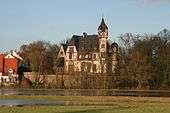 New Castle Büdesheim, Büdesheim (Schöneck), 1885
New Castle Büdesheim, Büdesheim (Schöneck), 1885 Lenbach Villa, Munich, 1887–1891
Lenbach Villa, Munich, 1887–1891- Villa of the painter Friedrich August von Kaulbach, Munich, 1887–1889
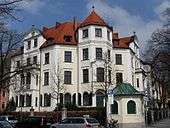 House on Bavariaring 24, Munich, 1888
House on Bavariaring 24, Munich, 1888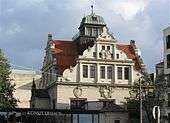 Künstlerhaus ("Artists' House") at Lenbachplatz, Munich, 1893–1900
Künstlerhaus ("Artists' House") at Lenbachplatz, Munich, 1893–1900 Bavarian National Museum, Munich, 1894–1899
Bavarian National Museum, Munich, 1894–1899 St. Anna's Church, Lehel, Munich, 1887–1892
St. Anna's Church, Lehel, Munich, 1887–1892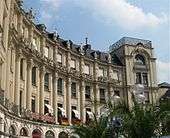 Rondell buildings at Karlsplatz, Munich, 1899–1900
Rondell buildings at Karlsplatz, Munich, 1899–1900- Schönau Water Castle, Schönau (Rottal), 1899–1900
 Lerbach Castle, Bergisch Gladbach, 1900
Lerbach Castle, Bergisch Gladbach, 1900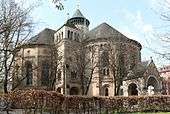 St. Rupert's Church, Munich, 1901–1903
St. Rupert's Church, Munich, 1901–1903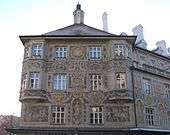 Ruffinihaus at Rindermarkt 10, Munich, 1903–1905
Ruffinihaus at Rindermarkt 10, Munich, 1903–1905 Neubeuern Castle, construction of the middle tract,[1] 1904–1908
Neubeuern Castle, construction of the middle tract,[1] 1904–1908- Corpshaus of the Corps Germania Munich
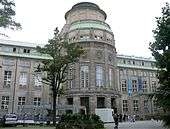 Deutsches Museum, Munich (begun in 1906; after Gabriel von Seidel's death in 1913 his brother Emanuel von Seidl continued the work until his own death in 1919; construction was completed in 1925)
Deutsches Museum, Munich (begun in 1906; after Gabriel von Seidel's death in 1913 his brother Emanuel von Seidl continued the work until his own death in 1919; construction was completed in 1925)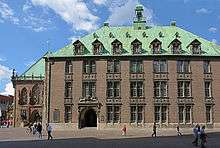 New Town Hall, Bremen, 1909–1913
New Town Hall, Bremen, 1909–1913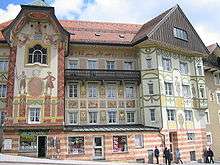 Redesign of Marienstift, Bad Tölz
Redesign of Marienstift, Bad Tölz Schloss Sandersdorf, renovation, 1900
Schloss Sandersdorf, renovation, 1900
Notes
References
- Stephan Bammer, Architekt, Natur- und Heimatschützer. Zum 100. Todestag von Gabriel von Seidl. ("Architect, and nature and heritage protector. On the 100th anniversary of the death of Gabriel von Seidl") In Schönere Heimat ("Nicer Home"), 102, p. 4–12, 2013.
- Hans Bössl, Gabriel von Seidl, Verlag des Historischen Vereins von Oberbayern ("Publisher of the Historical Society of Upper Bavaria"), Munich, 1966.
- Hans Herpich, Monumenta Germaniae, Gedenkblätter zum 100. Bundesfest des Corps Germania zu München ("Monumenta Germaniae: Commemoration of the 100th Corps Festival of the Corps Germania Munich"), Ingolstadt, 1963.
- Veronika Hofer (Ed.), Gabriel von Seidl. Architekt und Naturschützer. ("Gabriel von Seidl: Architect and conservationist"), Hugendubel Verlag, Munich, 2002. ISBN 3-7205-2295-4
- Wilhelm Neu, Volker Liedke, Otto Braasch: Denkmäler in Bayern ("Monuments in Bavaria"), Oldenbourg Wissenschaftsverlag, 1986. ISBN 978-3-486-52392-8
- Gabriele Schickel (not yet published), "Seidl, Gabriel", Neue Deutsche Biographie (NDB) (in German), 24, Berlin: Duncker & Humblot, pp. 180–181 Check date values in:
|date=(help); (full text online)
Documentary movies
- Gabriel von Seidl. Ein Architekt prägt München. ("Gabriel von Seidl: An architect shapes Munich"). TV documentary by Bernhard Graf, Germany 2004, BR, 45 minutes.
- Gabriel von Seidl. Architekt des bayerischen Heimatstils. ("Gabriel von Seidl: Architect of the Bavarian homeland style"). TV documentary by Bernhard Graf, Germany 2004, BR, 45 minutes.
External links
| Wikimedia Commons has media related to Gabriel von Seidl. |
- Literature by and about Gabriel von Seidl in the German National Library catalogue
- Gabriel von Seidl at the archINFORM database.
- Homepage of Gabriel-von-Seidl-Gymnasiums in Bad Tölz